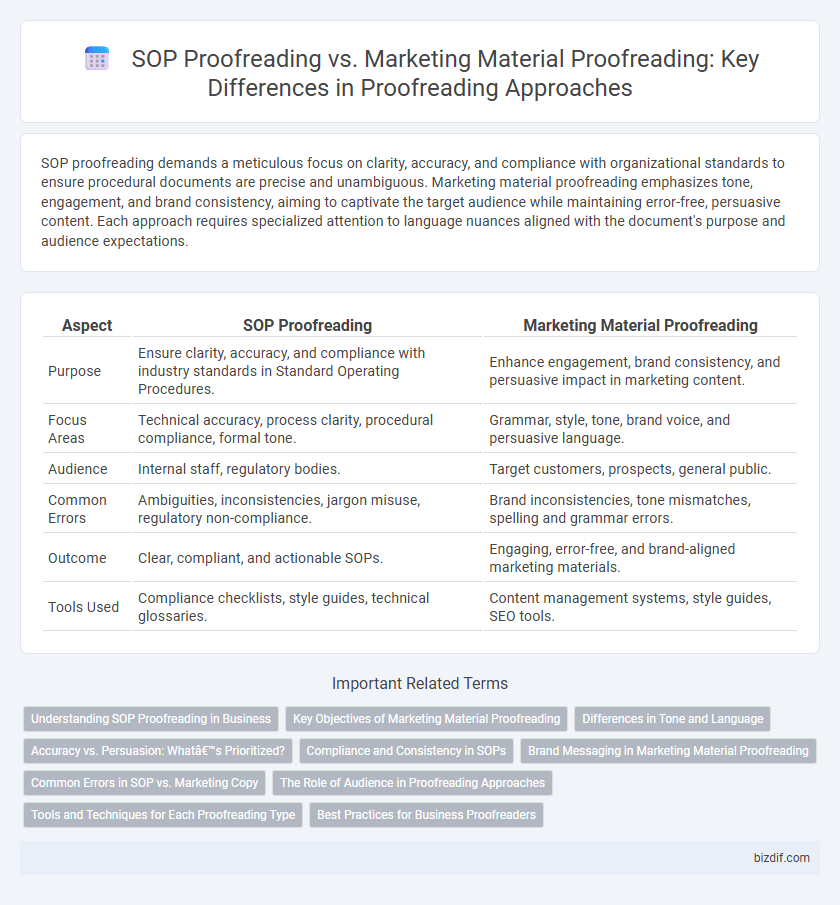SOP proofreading demands a meticulous focus on clarity, accuracy, and compliance with organizational standards to ensure procedural documents are precise and unambiguous. Marketing material proofreading emphasizes tone, engagement, and brand consistency, aiming to captivate the target audience while maintaining error-free, persuasive content. Each approach requires specialized attention to language nuances aligned with the document's purpose and audience expectations.
Table of Comparison
| Aspect | SOP Proofreading | Marketing Material Proofreading |
|---|---|---|
| Purpose | Ensure clarity, accuracy, and compliance with industry standards in Standard Operating Procedures. | Enhance engagement, brand consistency, and persuasive impact in marketing content. |
| Focus Areas | Technical accuracy, process clarity, procedural compliance, formal tone. | Grammar, style, tone, brand voice, and persuasive language. |
| Audience | Internal staff, regulatory bodies. | Target customers, prospects, general public. |
| Common Errors | Ambiguities, inconsistencies, jargon misuse, regulatory non-compliance. | Brand inconsistencies, tone mismatches, spelling and grammar errors. |
| Outcome | Clear, compliant, and actionable SOPs. | Engaging, error-free, and brand-aligned marketing materials. |
| Tools Used | Compliance checklists, style guides, technical glossaries. | Content management systems, style guides, SEO tools. |
Understanding SOP Proofreading in Business
SOP proofreading in business ensures that Standard Operating Procedures are clear, accurate, and consistent, preventing operational errors and promoting compliance with industry regulations. Unlike marketing material proofreading, which emphasizes persuasive language and brand tone, SOP proofreading prioritizes technical precision and clarity to facilitate employee understanding and standardized workflows. Accurate SOP documents reduce miscommunication, enhance productivity, and support quality control in various business processes.
Key Objectives of Marketing Material Proofreading
Marketing material proofreading focuses on ensuring brand consistency, clear messaging, and accuracy to effectively engage the target audience and drive conversions. It emphasizes the correction of grammar, spelling, tone, and style while aligning with marketing strategies and campaign goals. This process safeguards the company's reputation by enhancing readability, persuasive impact, and overall professionalism of promotional content.
Differences in Tone and Language
SOP proofreading requires a formal, precise tone emphasizing clarity and technical accuracy to ensure procedural compliance and standardization. Marketing material proofreading prioritizes engaging, persuasive language with a conversational tone designed to capture audience interest and drive conversions. These distinct approaches cater to the specific objectives of operational clarity in SOPs versus emotional appeal and branding in marketing content.
Accuracy vs. Persuasion: What’s Prioritized?
SOP proofreading prioritizes accuracy to ensure clarity, consistency, and compliance with formal standards, crucial for professional and academic credibility. Marketing material proofreading emphasizes persuasion, focusing on engaging language, brand voice, and emotional appeal to attract and convert potential customers. Balancing these priorities depends on the document's purpose, with SOPs demanding precision and marketing content requiring persuasive impact.
Compliance and Consistency in SOPs
SOP proofreading demands rigorous compliance with industry standards and regulatory guidelines to ensure operational consistency and accuracy. Unlike marketing material proofreading, which prioritizes persuasive language and brand voice, SOP proofreading focuses on uniform terminology and precise procedural descriptions. Ensuring strict adherence to protocol in SOPs mitigates risks and enhances organizational efficiency.
Brand Messaging in Marketing Material Proofreading
Marketing Material Proofreading prioritizes preserving and enhancing brand messaging to ensure consistency and impact across all platforms. This process involves meticulous checks for tone, voice, and style aligned with the brand's identity, distinguishing it from SOP Proofreading, which mainly focuses on clarity, accuracy, and procedural correctness. Effective Marketing Material Proofreading reinforces brand value and drives customer engagement through precise and persuasive language.
Common Errors in SOP vs. Marketing Copy
SOP proofreading often targets errors such as inconsistent tense, passive voice overuse, and unclear procedures, ensuring clarity and formal tone essential for compliance. Marketing material proofreading primarily focuses on correcting spelling mistakes, grammatical errors, and tone inconsistencies to maintain brand voice and engage target audiences effectively. Both require attention to detail, but SOPs demand precision and formality, while marketing copy emphasizes persuasive and error-free communication.
The Role of Audience in Proofreading Approaches
SOP proofreading prioritizes clarity, precision, and compliance with academic or professional standards to enhance credibility for admissions committees or employers. Marketing material proofreading emphasizes engaging language, brand voice consistency, and persuasive elements tailored to target customers for maximum impact. Understanding the distinct audience needs shapes the proofreading techniques applied to ensure optimal communication effectiveness.
Tools and Techniques for Each Proofreading Type
SOP proofreading relies heavily on precision tools such as style guides, compliance checklists, and specialized software to ensure adherence to industry standards and internal protocols. Marketing material proofreading utilizes advanced grammar and plagiarism checkers combined with readability scoring tools to enhance persuasive language and maintain brand voice consistency. Both types benefit from iterative reviews and collaborative feedback platforms, but each employs unique techniques tailored to their specific content goals and audience expectations.
Best Practices for Business Proofreaders
SOP proofreading demands meticulous attention to procedural accuracy and consistency, ensuring all operational instructions are clear and error-free. Marketing material proofreading prioritizes tone, brand voice, and persuasive language, alongside correcting grammar and spelling mistakes to enhance audience engagement. Best practices for business proofreaders include cross-referencing industry terminology, employing style guides specific to document type, and maintaining a balance between precision and readability.
SOP Proofreading vs Marketing Material Proofreading Infographic

 bizdif.com
bizdif.com